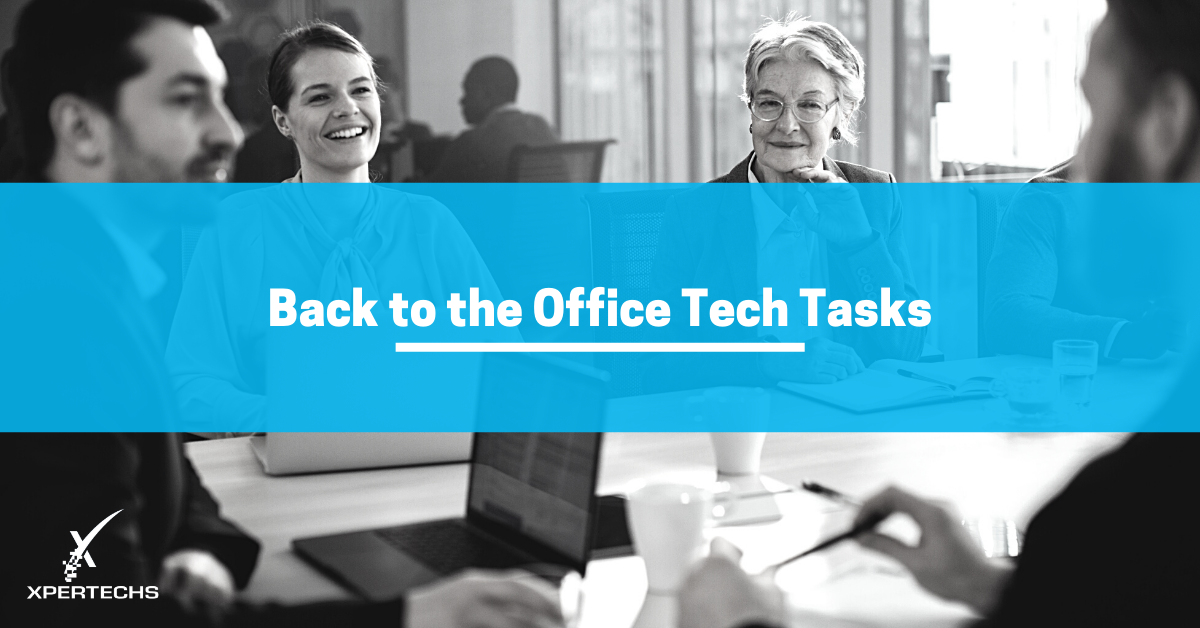Back to the Office Tech Tasks

As the worst of the COVID-19 pandemic recedes, some businesses are making moves to get workers back to the office. Clearly the importance of having a physical office has changed for those companies that discovered they could operate just as effectively with remote workers. Others, however, are eager to regain the benefits that can only come from having everyone under the same roof again, at least for part of the time.
We’ve seen this playing out in client activity here at XPERTECHS. For the last two plus years we’ve been concentrating on enabling clients and their employees with secure, remote working. Infrastructure projects that were focused on clients’ physical offices were put on hold. Now we’re seeing these projects being pulled to the front burner as companies have some or all of their employees return to the office.
Audit, Re-Evaluate and Improve
If you’re in a similar position and have delayed tech improvements at your office, there are several reasons why now is a good time to push them forward. There are also some tasks that you can add to your IT to-do list that will help you get a better handle on tech costs.
1. Make IT Improvements Before Prices Get Any Higher
Meet with your vCIO or technology advisor and revisit any projects that you may have delayed because of the pandemic. Technology manufacturers are raising their prices across the board due to high demand for products, low supply of certain raw materials, and supply chain struggles.
Any project that has to do with security should be moved to high priority. For example, if you know you need to upgrade your firewall, not doing so may actually increase your cyber risk.
Related: Plan Ahead to Avoid Computer Equipment Supply Problems
2. Perform an Inventory of Employee Equipment
Do an audit of all equipment in employees’ possession. If you had workers take home their laptops then that might be easier to do than if you bought everyone laptops and left their desktop workstations at the office. The same goes for monitors, docking stations and even phones.
Decide how you’re going to equip remote and hybrid workers going forward. Do they need two complete setups? Will they carry their laptops back and forth? Do in-house employees have equipment to return? As you get everyone setup with the arrangement that’s most conducive to their efficiency, collect unused equipment and either retire it, keep it in inventory or sell it.
3. Make Sure Your Employee Roster is Accurate
Many companies have had a lot of people coming and going these past two years. IT usually hears about new hires because they need new equipment but offboarding is another story. Performing an equipment audit may uncover computers that are unused or equipment that was supposed to be returned but wasn’t. There could even be equipment that was in fact returned but it’s sitting in a closet somewhere.
In addition to hardware, IT should shut down any accounts connected to former employees. Software licenses that they were utilizing should be canceled or transferred to another employee. If allocating hardware and software to employees is a messy process, that’s a sign that automation is needed to make sure that there aren’t any loose ends when an employee leaves.
Related: Streamline Employee Onboarding Processes with Power Apps
4. Review Software Licensing
In addition to making sure that you’re not maintaining software licensing for employees who have left, make sure that current employees have what they need. Roles may have changed and apps that were once needed, aren’t anymore.
As people return to the office, they might not need a mobile license for your line-of-business application. They may not need VPN anymore or you may have changed the way you provide secure remote access. The idea here is to make sure that you’re not paying for something that’s not being used anymore.
5. Re-evaluate How You’re Communicating
Lots of companies increased the number of meetings or check-ins that they had during the week just to keep people connected. This might be overkill if you have some or all of your people back in the office. It might be time to cut back on online meetings or even replace a meeting with an in-person or hybrid gathering.
Likewise, the use of Microsoft Teams really took off during the pandemic because it was exactly the communication tool that was needed to enable collaboration but it still doesn’t beat face-to-face interactions for relationship building. Encourage in-person engagement if possible and maybe it’s time to start up all company events again.
Do You Have an IT Strategy?
The activities on this task list might not look like it, but this is IT strategy. IT strategy is the process of getting all the benefits that you can from your technology. Of course, there’s a lot more to IT and security management that what we’re talking about here, but details matter and are necessary for reaching the goal of high functioning and efficient IT systems.
At XPERTECHS, we provide vCIO guidance to clients to help them plan and budget for IT improvements and to implement the kinds of best practices that makes their technology a solid foundation on which they can grow and innovate. If that’s not what you’re getting from your current IT company, it’s time to up your game.
Contact us for an IT consultation.
